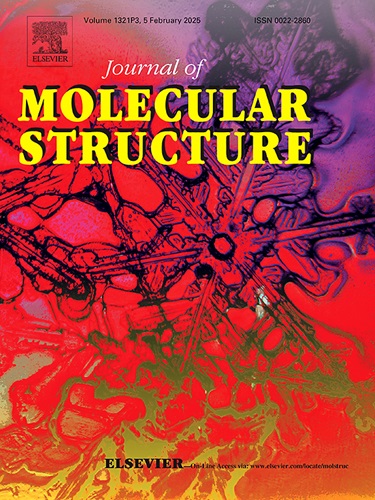异金属一维钛基配位聚合物的合成及CO2光催化还原
IF 4
2区 化学
Q2 CHEMISTRY, PHYSICAL
引用次数: 0
摘要
以Ti4L6为前驱体,在溶剂热条件下合成了四种新的过渡金属掺杂一维钛基配位聚合物[Ti2L2M(phen)] (M = Co2+, Ni2+, Cu2+, Zn2+, L = embononic acid, phen = 1,10-菲罗啉)。在[Ti2L2M(phen)]结构中,两个钛原子与两个L配体配位形成双核钛簇。L配体的羧酸基氧原子具有空位配位,进一步与M(phen)单元相互作用,形成z形的一维类链结构。所有化合物均通过单晶x射线衍射分析、热重分析、PXRD、UV-vis和IR光谱测定。值得注意的是,所有框架都表现出优异的稳定性,可以作为多相催化剂在光照条件下将CO2还原为合成气(CO+H2)。具体来说,Ti2L2Co的合成气总产率高达20.3 mmol g-1 h-1本文章由计算机程序翻译,如有差异,请以英文原文为准。
Synthesis and CO2 photocatalytic reduction of heterometallic one-dimensional titanium-based coordination polymers
Four new transition metal doped one-dimensional titanium-based coordination polymers, [Ti2L2M(phen)] (M = Co2+, Ni2+, Cu2+, Zn2+, L = Embonic acid, phen = 1,10-phenanthroline), have been synthesized under solvothermal conditions utilizing the Ti4L6 precursors. In the structure of [Ti2L2M(phen)], a dinuclear titanium cluster is formed by coordinating two Ti atoms with two L ligands. The oxygen atoms from the carboxylate groups of the L ligands, which possess vacant coordination sites, further interact with the M(phen) unit, resulting in a Z-shaped one-dimensional chain-like structure. All compounds are determined by single crystal X-ray diffraction analysis, thermogravimetric analysis, PXRD, UV–vis and IR spectra. Notably, all frameworks exhibit excellent stability and can be used as heterogeneous catalysts to reduce CO2 to syngas (CO+H2) under light conditions. Specifically, the total yield of syngas for Ti2L2![]() Co is up to 20.3 mmol g–1 h–1
Co is up to 20.3 mmol g–1 h–1
求助全文
通过发布文献求助,成功后即可免费获取论文全文。
去求助
来源期刊

Journal of Molecular Structure
化学-物理化学
CiteScore
7.10
自引率
15.80%
发文量
2384
审稿时长
45 days
期刊介绍:
The Journal of Molecular Structure is dedicated to the publication of full-length articles and review papers, providing important new structural information on all types of chemical species including:
• Stable and unstable molecules in all types of environments (vapour, molecular beam, liquid, solution, liquid crystal, solid state, matrix-isolated, surface-absorbed etc.)
• Chemical intermediates
• Molecules in excited states
• Biological molecules
• Polymers.
The methods used may include any combination of spectroscopic and non-spectroscopic techniques, for example:
• Infrared spectroscopy (mid, far, near)
• Raman spectroscopy and non-linear Raman methods (CARS, etc.)
• Electronic absorption spectroscopy
• Optical rotatory dispersion and circular dichroism
• Fluorescence and phosphorescence techniques
• Electron spectroscopies (PES, XPS), EXAFS, etc.
• Microwave spectroscopy
• Electron diffraction
• NMR and ESR spectroscopies
• Mössbauer spectroscopy
• X-ray crystallography
• Charge Density Analyses
• Computational Studies (supplementing experimental methods)
We encourage publications combining theoretical and experimental approaches. The structural insights gained by the studies should be correlated with the properties, activity and/ or reactivity of the molecule under investigation and the relevance of this molecule and its implications should be discussed.
 求助内容:
求助内容: 应助结果提醒方式:
应助结果提醒方式:


